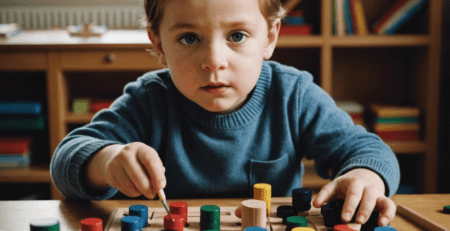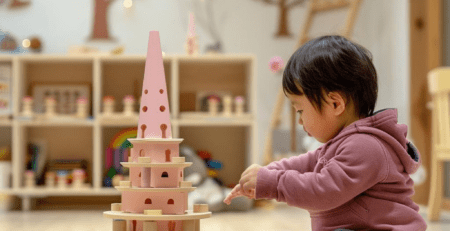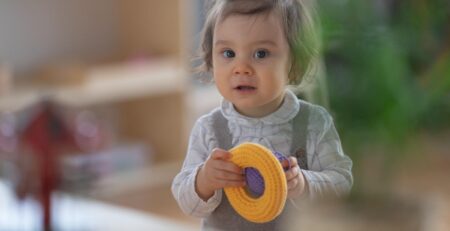
23
Montessori Math: A Holistic Approach to Early Education
Welcome to the world of Montessori math, where learning becomes a journey of discovery and exploration. In this article, we will delve into the unique approach to mathematics education developed by Maria Montessori, which emphasizes hands-on learning and individualized instruction. From the use of manipulative materials to the focus on concrete understanding, Montessori math offers a refreshing alternative to traditional methods. Join us as we explore the principles and practices that make Montessori math a transformative experience for young learners.
Table of Contents
- Introduction
- History of Montessori Math
- Principles of Montessori Math
- Materials used in Montessori Math
- Benefits of Montessori Math
- Implementation of Montessori Math
- Q&A
- Wrapping Up
Introduction
Welcome to our comprehensive guide on Montessori Math! In this post, we will delve into the Montessori method of teaching math to young children, exploring the principles, materials, and techniques that make it such a unique and effective approach.
Montessori Math is based on the educational philosophy of Dr. Maria Montessori, an Italian physician and educator who developed an innovative approach to teaching mathematics to young children. The method focuses on providing children with a hands-on, experiential learning experience, allowing them to explore mathematical concepts through sensory activities and manipulative materials. By engaging children in a concrete way, Montessori Math aims to build a strong foundation of mathematical understanding and critical thinking skills that will serve them well throughout their education and beyond.
History of Montessori Math
The dates back to the early 1900s when Dr. Maria Montessori, an Italian physician and educator, developed the Montessori method of education. Dr. Montessori believed that children learn best through hands-on, interactive experiences, and she developed a unique approach to teaching math that continues to be influential in early childhood education today. The Montessori math curriculum is based on the principles of exploration, discovery, and self-directed learning, allowing children to develop a deep understanding of mathematical concepts at their own pace.
Key Developments in Montessori Math
1. Decimal System: Dr. Montessori introduced the decimal system to teach children about the concept of place value, allowing them to understand the relationship between ones, tens, hundreds, and thousands.
2. Manipulative Materials: Montessori math materials, such as the golden beads and number rods, are specifically designed to provide children with concrete experiences that help them internalize abstract mathematical concepts.
3. Linear Counting: Dr. Montessori also developed the concept of linear counting, which helps children grasp the sequence of numbers and understand the patterns and relationships between them.
The Montessori math method has evolved over the years, but its core principles of hands-on learning and individualized instruction continue to shape the way children learn and understand mathematics.
Principles of Montessori Math
Montessori math is a unique and effective approach to teaching mathematics to young children. Based on the principles developed by Dr. Maria Montessori, this method emphasizes hands-on learning, exploration, and discovery. The goal of Montessori math is to help children develop a deep understanding of mathematical concepts rather than simply memorizing facts and procedures. Here are some key :
- Concrete learning: In Montessori math, children work with physical materials such as beads, rods, and number cards to explore mathematical concepts. This hands-on approach allows children to develop a concrete understanding of abstract mathematical ideas.
- Self-paced learning: Montessori math encourages children to work at their own pace, allowing them to take the time they need to fully grasp each concept before moving on to the next. This fosters a sense of independence and self-motivation in learning.
- Multi-sensory learning: The Montessori math curriculum incorporates visual, auditory, and tactile experiences to engage all of a child’s senses in the learning process. This multi-sensory approach helps children build a strong foundation in mathematical understanding.
Overall, the aim is to provide children with a solid foundation in mathematical concepts while fostering a love of learning and exploration. By embracing these principles, children develop not only mathematical skills but also a deeper understanding of the world around them.
Materials used in Montessori Math
When it comes to Montessori math, the materials used play a significant role in creating a hands-on and interactive learning environment for children. These materials are carefully designed to help children understand mathematical concepts through exploration and manipulation. Some of the key materials used in Montessori Math include:
- Number Rods: These are wooden rods of varying lengths, each painted in a different number from 1 to 10. They help children understand the concept of quantity and numerical order.
- Sandpaper Numbers: These tactile materials allow children to trace and associate the shape of each number with its quantity, helping them develop a strong foundation in number recognition.
- Golden Beads: These beads are used to introduce children to the decimal system and place value, making abstract concepts more concrete and tangible.
- Number Cards: These cards feature numerals and number symbols, allowing children to practice matching, sequencing, and associating the quantity with the numeral.
These materials are carefully crafted to support the Montessori method’s emphasis on exploration, discovery, and self-paced learning. By providing children with concrete objects to manipulate and explore, these materials help build a deep and lasting understanding of mathematical concepts.
Benefits of Montessori Math
Montessori math education offers a unique and effective approach to teaching fundamental mathematical concepts to young children. This method focuses on hands-on learning, individualized instruction, and the use of specially designed materials to help children develop a deep understanding of mathematical concepts. Here are some of the key :
- Concrete Learning: Montessori math materials are specially designed to provide children with concrete representations of abstract mathematical concepts. This hands-on approach helps children develop a strong foundation in math and enables them to understand complex ideas at a young age.
- Individualized Instruction: In a Montessori classroom, children are encouraged to learn at their own pace. This allows them to progress through mathematical concepts at a speed that is comfortable for them, leading to a deeper and more comprehensive understanding of math.
- Develops Critical Thinking Skills: Montessori math activities are designed to promote problem-solving and critical thinking skills. Children are encouraged to explore and manipulate materials, which helps them develop a deep understanding of mathematical concepts and how they can be applied in real-life situations.
- Promotes a Love for Learning: Montessori math education focuses on making math enjoyable and engaging for young children. By fostering a love for learning and exploration, children develop a positive attitude towards math that can set the stage for future academic success.
Overall, Montessori math education offers a unique and effective approach to teaching math to young children. By providing hands-on learning experiences, individualized instruction, and promoting a love for learning, this method helps children develop a deep understanding of mathematical concepts and sets the stage for future academic success.
| Concrete Learning | Hands-on approach |
| Individualized Instruction | Learn at their own pace |
| Develops Critical Thinking Skills | Promotes problem-solving |
| Promotes a Love for Learning | Makes math enjoyable |
Implementation of Montessori Math
Implementing Montessori math in the classroom involves a unique approach to teaching mathematical concepts that focuses on hands-on learning and individualized instruction. This method, developed by Maria Montessori, emphasizes the use of specially designed materials and activities to help children develop a deep understanding of mathematical concepts through exploration and discovery.
When incorporating Montessori math into the classroom, teachers can introduce a wide range of manipulative materials such as number rods, golden beads, and spindle boxes. These materials are carefully designed to help children visualize and internalize abstract mathematical concepts. By engaging in activities with these materials, students are able to develop a concrete understanding of mathematical principles, laying a strong foundation for future learning.
One of the key principles of Montessori math is allowing children to progress at their own pace. This individualized approach ensures that students can fully grasp each mathematical concept before moving on to more complex ideas. Additionally, hands-on activities such as sorting, patterning, and counting help to make math enjoyable and accessible for young learners, fostering a positive attitude towards mathematics.
Q&A
Q: What is Montessori math?
A: Montessori math is a method of teaching mathematics based on the principles of Maria Montessori, an Italian physician and educator. It emphasizes hands-on learning, self-paced instruction, and the use of specially designed materials to help children understand mathematical concepts.
Q: How does Montessori math differ from traditional math education?
A: In traditional math education, children are often taught through lectures, worksheets, and memorization. Montessori math, on the other hand, focuses on active learning and allows children to explore mathematical concepts through concrete materials and real-life experiences.
Q: What are some of the materials used in Montessori math?
A: Montessori math materials include manipulatives such as beads, rods, and cubes, as well as specialized, self-correcting workbooks. These materials help children to understand abstract mathematical concepts by providing a hands-on way to explore and experiment with numbers and operations.
Q: Can Montessori math be applied at home?
A: Yes, many parents choose to incorporate Montessori math principles and materials into their at-home learning experiences. This allows children to learn math in a way that is developmentally appropriate and engaging, promoting a love of learning and deeper understanding of mathematical concepts.
Q: What age range is Montessori math suitable for?
A: Montessori math can be adapted for children of all ages, from preschool through elementary school. The materials and lessons are designed to meet children at their individual levels and support their ongoing mathematical development.
Wrapping Up
In conclusion, Montessori math offers a unique and effective approach to teaching mathematical concepts to young children. By utilizing hands-on materials, promoting independent learning, and fostering a love of numbers, Montessori educators are able to help children develop a strong foundation in math from an early age.
Through the use of specially designed materials and a carefully planned curriculum, children are able to progress at their own pace and gain a deep understanding of mathematical concepts. This approach not only helps children build a strong foundation in math, but also fosters a love for learning and problem solving.
Overall, Montessori math provides a comprehensive and holistic approach to teaching mathematics to young learners, setting them up for success both academically and in their future endeavors. By embracing the principles of Montessori education, educators can provide children with the tools they need to become confident and competent mathematicians.
Incorporating Montessori math principles into early childhood education can set the stage for a lifetime of mathematical success and a deep appreciation for the beauty of numbers. As we continue to explore new ways of teaching and learning, the Montessori approach to math stands out as a timeless and effective method for developing young minds.










